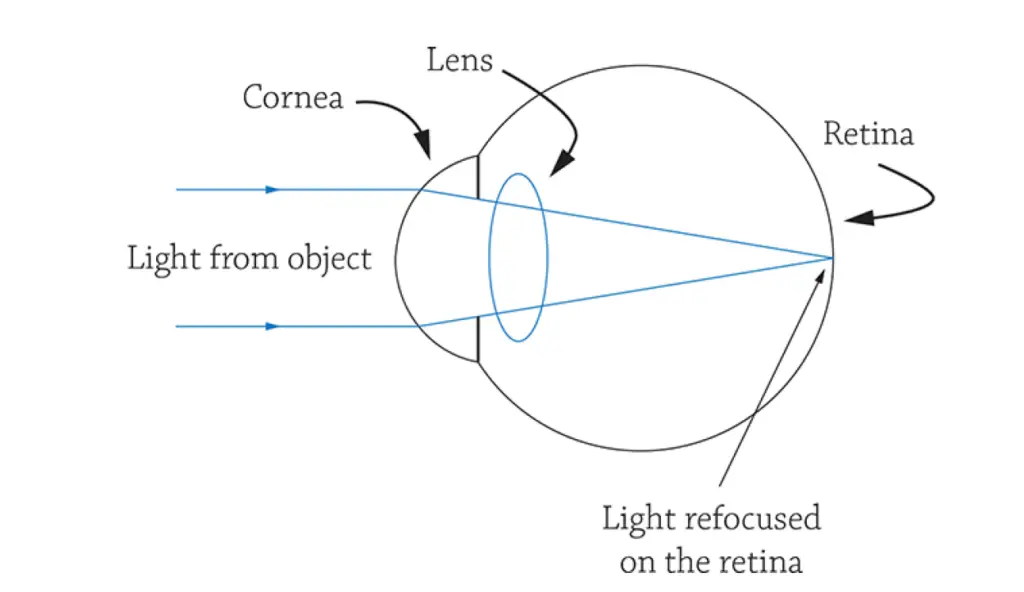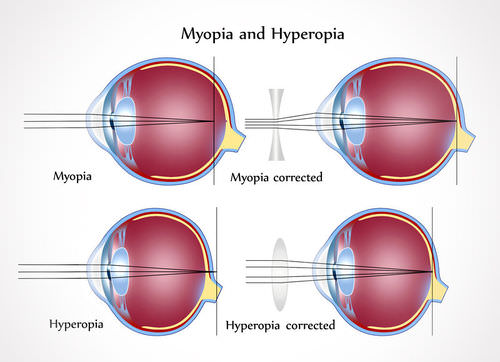What are hyperopia & myopia – symptoms, reasons, and fixes
Two of the most common vision problems are myopia and hyperopia where images of objects are not properly focused on the retina of the human eyes. To understand these let’s briefly discuss how human eyes act as compounded lenses. If we understand this first, it will be better for us to understand the symptoms & reasons for hyperopia & myopia and how to fix these with the help of lenses.
Human Eyes as Compound Lenses
Human Eyes are actually compound lenses, as they have two refractive surfaces. (See the figure below.)

Here are the steps that are followed during the viewing process by human eyes.
- Light from objects first enters the cornea, which acts as a smooth hard outer lens to protect the inner eye.
- The cornea also bends the incoming light. In fact, the cornea does as much as 75 percent of the refracting for the eye.
- Next, the light enters the lens.
- Lens is flexible. Muscles and ligaments in our eye bend and shape the lens. This changes the focal length of the lens for fine-tuning the image location.
- When our eyes are correctly focusing on an object, a clear image will form on the retina.
- Nervous system sensors pick up the color and brightness of the image and send this to the brain.
- Since the image on the retina must be a real image, it is inverted.
- Human brain flips the image over so that we see the world properly.
Not all eyes can focus properly. Let’s see what are the causes of these abnormalities and how to fix these issues.
Hyperopia or Farsightedness
Farsightedness is also known as hyperopia. It affects about one-fourth of people.
symptoms
People with hyperopia can see distant objects clearly, but nearby objects appear blurry.
Common signs of farsightedness include difficulty in concentrating and maintaining a clear focus on close objects, eye strain, fatigue and headaches after close work, and aching or burning eyes, especially after intense concentration on close work.
reason of hyperopia
In hyperopia, the eye is too short. This results in images being focused behind the retina (Figure 2).
how to fix hyperopia
To fix this problem, we need a lens that converges the light before it enters the eye. Therefore, the corrective lens is a convex lens. Hyperopia is corrected with a convex lens, which curves outward like the outside of a bowl. The lens changes the focus so that images fall on the retina as they should.
Below, you can see how images are focused with hyperopia and its fix with the help of a convex lens. (Figure below).

Myopia or Nearsightedness
Myopia is also called nearsightedness. It affects about one-third of people.
symptoms
People with myopia can see nearby objects clearly, but distant objects appear blurry.
reason of Myopia
In myopia, the eye is too long. This results in images being focused too soon in front of the retina.
how to fix Myopia
To fix this problem, we need a lens that diverges the light before it enters the eye so that the focus point moves back to the retina. Therefore, the corrective lens is a concave lens.
Myopia is corrected with a concave lens, which curves inward like the inside of a bowl. The lens changes the focus, so images fall on the retina as they should.
Below, you can see how images are focused with myopia and its fix with the help of a concave lens. (Figure below).

Relevant knowledge
- Generally, nearsightedness first occurs in school-age children. There is some evidence that myopia is inherited.
- Individuals who spend a lot of time reading, working, or playing at a computer, or doing other close visual work may also be more likely to develop nearsightedness.
- Because the eye continues to grow during childhood, myopia typically progresses until about age 20.
- However, nearsightedness may also develop in adults due to visual stress or health conditions such as diabetes.
- A common sign of nearsightedness is difficulty seeing distant objects like a movie screen or the TV, or the whiteboard or chalkboard in school.
- Generally, Eyeglasses or contact lenses can easily help with myopia.
- Depending on the amount of myopia, we may only need to wear glasses or contact lenses for certain activities, like watching a movie or driving a car. Or, if we are very nearsighted, they may need to be worn all the time.
- In addition to lenses, many cases of myopia and hyperopia can be corrected with surgery. For example, a procedure called LASIK (Laser-Assisted in situ Keratomileusis) uses a laser to permanently change the shape of the cornea so light is correctly focused on the retina.
Summary

- Vision problems such as myopia and hyperopia can be corrected with lenses that help focus light on the retina.
- Myopia is corrected with a concave lens, while hyperopia is corrected with a convex lens
